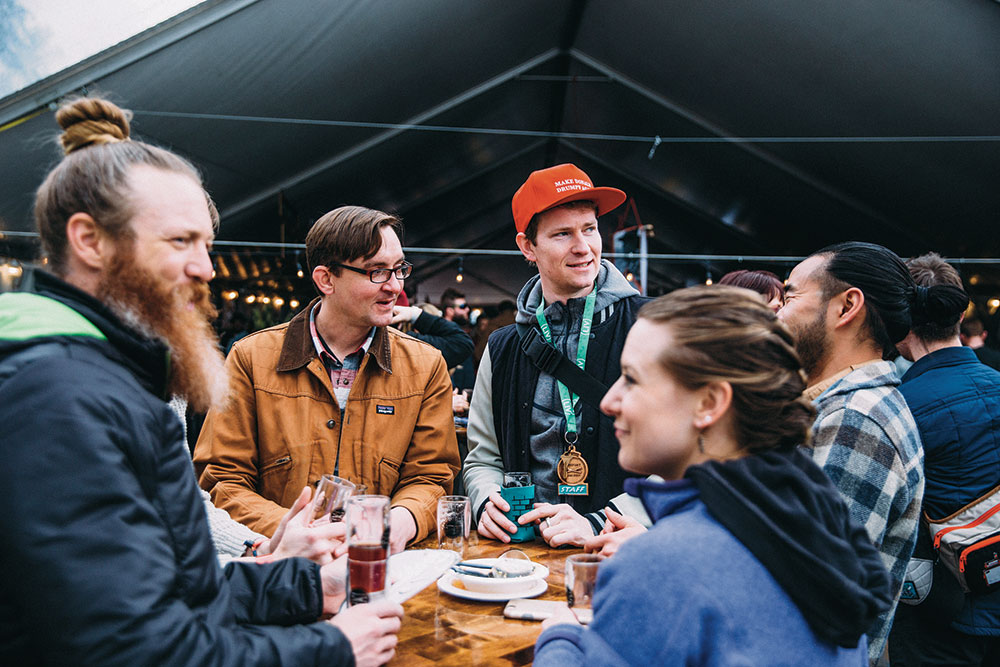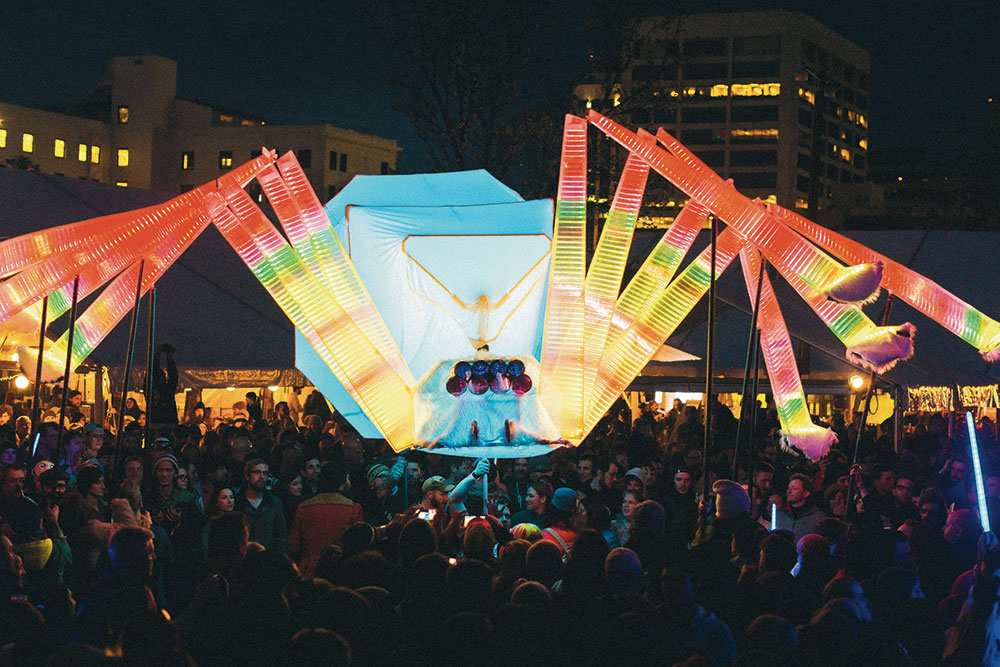March might just be Boise’s favorite month.
On a pre-spring Wednesday night in its “Linen District,” an event blossoms from Neurolux and the El Korah Shrine, spreads over four entire city blocks and spills into downtown.
The ‘Spotify meets street fair-vibe Treefort Music Festival has a life of its own. Pumping people and commerce into Idaho’s Capitol, an otherwise slower month turns into the busiest time of the year, as streets come alive with festival-going pedestrians and cyclists.
No matter the weather, fans of all ages huddle together like kids at that dream summer camp where everyone gets along as lines of genre, elitism, and careers blur. With no VIP seating, no specific rock, hip-hop, or blues section, the mix is intentional.
“It’s a festival of discovery,” co-founder Eric Gilbert explained.
“We’ve learned not to stereotype an experience,” co-founder Lori Shandro Outen added.
At first, Treefort was not intended as a music festival. The seed took root in June 2009, when Shandro Outen suddenly lost her husband in a private plane crash. In an instant, she was the single working mother of two young children.
 A strong businessperson with great people skills, the music-loving Shandro Outen had much on her mind that year, with one ongoing side frustration. “Emerging artists came through Boise, but didn’t play there. If I wanted to see them, I had to travel. That wasn’t feasible for a single mom.”
A strong businessperson with great people skills, the music-loving Shandro Outen had much on her mind that year, with one ongoing side frustration. “Emerging artists came through Boise, but didn’t play there. If I wanted to see them, I had to travel. That wasn’t feasible for a single mom.”
She shared her thoughts at the ski and bike shop where she was a regular with fellow music fan, shop employee Drew Lorona.
“There was a lot of music in Boise. We thought we should have a more prosperous music scene,” said Lorona, who was also a Boise State MBA student seeking an internship at the time.
“Could you get credit for writing a business plan for a venue that hosted and highlighted emerging artists?” Shandro Outen asked Lorona.
Lorona spent the next few months researching. A talent agency executive suggested that the two begin promoting shows to build both reputation and funds for the proposed venue, and also suggested they talk to someone in the music business, passing along the name of Eric Gilbert.
To Shandro Outen, the name was familiar. Gilbert was a deejay at KBRX Radio Boise, a listener-supported, independent radio station.
“Eric was a huge inspiration,” she said, “His show was all about emerging artists and touring bands.”
Gilbert started the popular band “Finn Riggins” with his wife and a good friend. Touring the country from 2007 through 2011, he’d played multiple festivals and had connected with multiple bands.
In the fall of 2011, during time off from Gilbert’s second job at Pie Hole on Eighth Street, Gilbert, Shandro Outen, and Lorona crossed the street to nearby Bittercreek Alehouse. Gilbert shared ideas of a one-day festival right after the Boise Showcase of South by Southwest, something with which he was involved.
The idea to put local, national, regional, and international artists on the same stage to prove Boise’s relevant music scene appealed to Shandro Outen and Lorona.
“It was a timing thing,” said Gilbert, “Post-recession, RadioBoise on the FM airwaves, a lot of Boise music scene momentum, and more local excitement, in general. It just felt right.”
A budget was allowed to discover what interest could be generated. Two weeks later, Gilbert had enough bands to fill a three-day event.
Around the same time, Gilbert approached Megan Stoll, a laid-off marketer who’d been spending time floating the river, going to a lot of shows, and job-hunting. Completing the founding group, Stoll immediately initiated an ambitious social media campaign.
Lorona, Stoll, and Gilbert were all Radio Boise deejays who understood that synchronicity between community, organizers, artists, and audience was needed.
Spanning three days and hosting about 70 bands, ‘Treefort’ was born in March 2012, an instant giant that quickly grew to five days and 450 bands.
“It’s not hyperbole to say it kind of blew up,” said Lorona.
For Shandro Outen, working on something of that magnitude was cathartic.
“It was very much a healing project. Creating from grief is more productive than being angry and destructive. When tragedy happens, you have the horrible. If you don’t find the blessings and learn the lessons, it’s just horrible for horrible’s sake.”
It was important to Shandro Outen that Treefort be different, to stand out.
“I didn’t want to see a band from two football yards away. I wanted every experience to be up close and personal.”
Luckily, Boise was a city that thrived on the personal and collaborative.
Shandro Outen related, “The mayor’s office was amazingly supportive. I’ve lived in Seattle, San Francisco, and San Diego and can’t imagine effecting change like that in those places. This is the most accessible city.”
Boise’s helpful spirit added yet another layer to Treefort’s success.
“We have a staff of 40 and approximately 700 volunteers that make this happen,” said Gilbert, “It’s amazing how many people care. Twenty-five stages run simultaneously, things stay on time. This is a passion project.”
Another goal was to make sure the artists felt welcomed and were treated well.
“Eric’s being a musician and Lori’s generous personality called for added value for our artists,” said Lorona. “That came in the form of hospitality. Hotels, decent meals. If they wanted to stay all weekend, we tried to accommodate them with additional shows, not just ‘play your set, eat your free pizza and get out.’”
Stoll agreed, “Businesses donated so many things for the artists’ lounge and artists’ bags. Boise School of Rock had students draw bands’ names on the bags. It’s unique.”
Businesses extended discounts to those wearing Treefort wristbands, put signs in their windows, and offered venues for bands that wanted to play even more.
Perhaps consequently, Treefort’s first year yielded an unexpected side effect: the creation of other forts.
David Roberts first approached the founders with the idea of ‘Alefort’.
“We felt that was a pretty good pairing,” laughed Gilbert.
“We said, ‘hey, you know, I think a Yogafort and a tech conference could work,” remembered Lorona, “We tried to have the forts start small, so there wasn’t a lot of risk.”
When the local tech scene expressed interest, “Hackfort” emerged. Up to that point, it had been difficult for Boise to compete with the San Franciscos and Seattles of the world.
Treefort was the perfect vehicle for recruiting, since most tech talent wanted to live in a culturally vibrant location.
When Boise State University got involved with Hackfort (now called a digital community conference), the fort continued to grow.
“There was some skepticism,” Lorona admitted, “I had no idea Yogafort would sell out in its second year. But people like Marisa Weppner from Sage Yoga, so well-respected in the yoga community, did such a good job of programming, the event quickly became a staple.”
Other forts followed.
Modeled after the traditional film festivals, filled with new works that will be at Sundance in the coming year, Filmfort completed its fourth season. 2016’s Idaho Writer in Residence Christian Winn directed the gathering of local and international fiction, nonfiction, and poetry writers through Storyfort. The Boise Skateboarding Association hosted Skatefort, a one-day event. Kidfort comprised shadow puppet shows, storytelling, and kid-focused programming. The combination of local growers with local chefs for tastings of local food became Foodfort. With so many local visual artists to feature, this year marked the introduction of the Treefort Art Gallery.

“The forts relate directly to up-and-coming or already-prominent parts of our community,” said RedSky PR’s Marissa Lovell, “such as the Treefort Art Gallery. Art isn’t new here, but more collectives and galleries are appearing. These forts are a tribute and gathering place for what we have going on in Boise.”
As the founders’ main job morphed into growth management, all realized the enormous crossover potential.
“People get stuck in their ‘silos’,” offered Gilbert, “Treefort provides opportunities to stumble onto something they wouldn’t normally go to. Musicians are seeing new films, film directors are attending Hackfort panel talks, yoga classes are paired with live music.”
For many, the Treefort opportunities are career changing, life-altering magic.
Boise gets significant March revenue, and the ripple effects are felt as far away as McCall and Sun Valley. Scores of people get a stage for their talents. Similar ‘fort-style’ festivals are springing up in other places such as Everett, Washington, Reno, and Seattle.
And the founders?
They’re now doing what they do best, with Boise taking them a step further by making Treefort the city’s Cultural Ambassador.
“It was a really cool move of them,” Gilbert said. “We’ve taken that responsibility pretty seriously, reaching out to other communities, taking local bands to showcases at New York, Reno, Denver. It’s something we do year-round.”
The group that wanted to bring the masses to Boise is now bringing Boise to the masses, and the four have no problem singing its praises.
“Treefort is a result of the people here,” said Stoll, “We all know this is the nicest city in the world. I think that shows during Treefort and helps the festival grow without trying too hard. It’s just the inherent niceness here.”
“It’s a big small town,” Shandro Outen agreed, then commented reflectively on her experience: “If you’re going to get the grief and awfulness, you may as well open your eyes to the blessings, the helpful people that come out of the woodwork, and the lessons you can learn.”
“It’s very satisfying to be a part of making this happen, to watch people enjoying themselves,” Shandro Outen added. “I definitely feel like I was just lucky enough to get to be the person that helped shepherd the things people are so passionate about. It all blended so easily, because it’s Boise.”
Explore the Fort:
Short attention spans work in your favor at Treefort! Jumping from venue to venue won’t detract; it’s encouraged. All day for five days, you can get to know the performers you see around town, talk new apps with Hackfort participants, drink and dine at the broad range of tempting culinary and liquid offerings, meet a multitude of new friends and dance to the music of your new favorite bands. Dress in layers, pack some snacks, prepare for whatever Boise’s variable weather decides to do that day, and get ready for the time of your life.
A Sampling of the Treefort Lineup:
The Growlers, Why?, The Bouncing Souls, Touche Amore, Alvays, Dead Meadow, The Infamous Stringdusters, Lower Dens, Kate Tempest, The Coathangers, Lizzo, The Album Leaf, Kishi Bashi, Grouper, Clap!Clap!, Delicate Steve, AJJ, Andy Shauf, Eilen Jewell, Rituals of Mine, The Dig
Want to Volunteer?
Over a dozen nonprofit and community organizations participate in the festival and engage with thousands of festival attendees. These organizations provide interactive volunteer experiences outside of the Treefort Main Stage, register voters and bone-marrow donors, enjoy Treefort as Bigs & Littles, host a daylong service project, engage refugees to volunteer with the festival, and present a panel discussing volunteerism leading to careers in Idaho.
If your nonprofit is interested in engaging with the community during Treefort, please visit Treefort’s website at treefortmusicfest.com.
